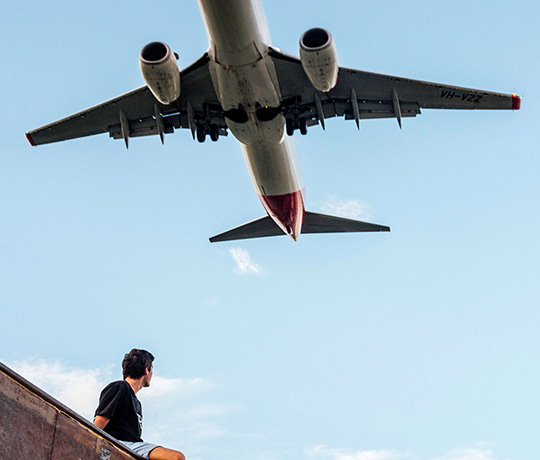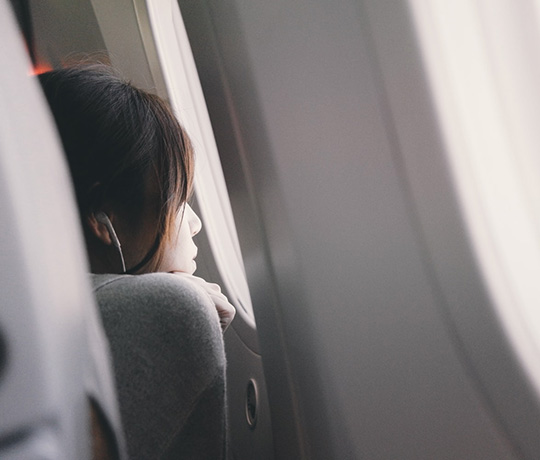How students can reduce their CO2 emissions by carbon offsetting flights, participating in environmental programs and saving the planet from the aisle seat.

News flash, everyone: climate change is kind of getting to be a problem.
The Earth is in trouble. The atmosphere is getting warmer and more polluted every day, and there’s no shortage of scientists warning us that doomsday is inching closer and closer. It’s easy to give platitudes like ‘we all need to work together! Do your part!’ but taking action can be a lot harder, especially when we’re in a country like Australia where we’re lucky enough to not experience any severe, detrimental effects of climate change.
But working together and doing your part may actually be a lot simpler than you think. You don’t need to move out to the middle of nowhere and live in a cottage and eat shrubbery for the rest of your life – in fact, you could be helping slow down climate change just by making small, easy changes in the choices you make. Turning off the shower when you shave. Putting food waste in compost instead of general waste. Switching the light off in a room you’re not using. And… carbon offsetting your flights.
What the heck does it mean to carbon offset your flights?
Glad you asked. Aviation is responsible for about 2% global carbon dioxide emissions – and carbon dioxide emissions are part of what’s killing the planet. In 2016 alone, Australia’s domestic and international aviation sector released the equivalent of 22 million tonnes of carbon dioxide. You can only imagine how that must add up when you consider the lack decade. In an effort to try and reduce the impact of flights on the environment, most airlines offer some form of what is called carbon offsetting, where customers pay a few extra dollars when paying for an airfare that goes towards an initiative that carries out environmental sustainability projects.
Price varies from flight to flight – usually, it’s around the total estimated carbon emissions produced by your flight divided by the number of seats on the plane, then multiplied by the cost of offsetting one tonne of carbon. Seems fair enough! This means shorter trips charge less, and longer trips charge more, as they are, in essence, worse for the environment the longer they are, as that’s all the more carbon dioxide being released. You’ll pay less than a dollar for a flight between Melbourne and Sydney, and somewhere around $50 from Melbourne to London. $50 to save the planet? That’s just the tips I get in a couple of hours. It’s a yes from me!

But where does this money go when I carbon offset?
Most commonly, the initiatives funded by carbon offsetting are dedicated to replanting trees, stopping deforestation, renewable energy projects as well as community efforts. Some popular offset initiatives around the world include Qantas’ Future Planet, which is supposedly the largest airline offsetter and uses a mix of reforestation, forest protection and renewable energy; other verified schemes include Air Canada’s work with Less Emissions, Brussels Airlines with CO2 Logic, KLM’s CO2ZERO and Austrian Airlines with Carbon Austria.
There aren’t enough passengers taking advantage of carbon offsetting opportunities, mostly due to reasons such as mistrust of airlines or unwillingness to pay more money (even if it is to save the planet and make a better world for their children).
Mostly, it’s just lack of information. Making such a small tweak to your flight booking could plant a tree, stop a forest collapsing, heal the planet – for something so easy, it should be an obvious choice, right? If you’re not doing anything else to reduce your carbon footprint, carbon offsetting is a million miles better than nothing. International and interstate students are regular flyers, frequently taking flights in order to visit family. We’re not suggesting you stop that – but considering that major airlines like Qantas, Jetstar and Virgin offer carbon offsetting and you’ll pay less than a dollar for a domestic flight, you should consider the impact you could make at less than the cost of a granola bar.

So, next time you fly home to visit your family or take a weekend beach trip interstate with your friends, check to see if you have any spare cash and consider looking into your airline’s carbon offsetting program. No cabin in the woods. No plant-eating. Just ticking a little box, and maybe just maybe, you could help save our planet.
If you want to roughly check how much carbon offsetting your next flight might cost, use this calculator.












